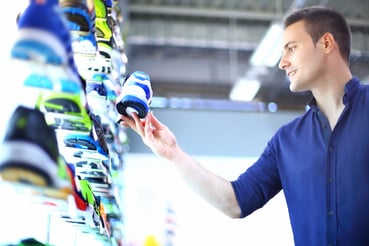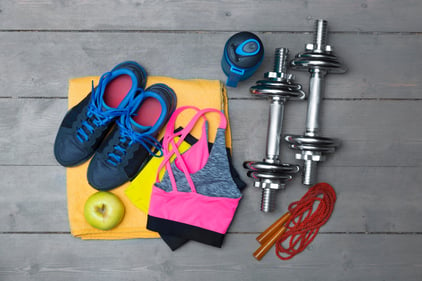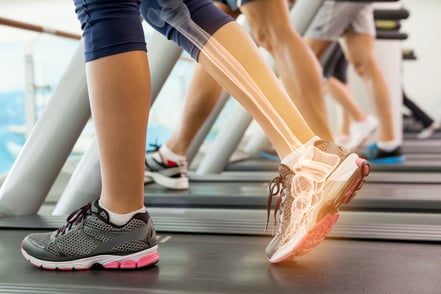 The correct footwear plays a vital role in your time running on the road or just walking around at home or work. But what makes a good running shoe? With a wide variety of options it can be hard to determine the best fit for your foot type. Knowing if your foot is normal, flat, or high-arched can play a role in the type of shoe best for you. An employee at a fitness store should be able to help you determine the best type of shoe for your foot.
The correct footwear plays a vital role in your time running on the road or just walking around at home or work. But what makes a good running shoe? With a wide variety of options it can be hard to determine the best fit for your foot type. Knowing if your foot is normal, flat, or high-arched can play a role in the type of shoe best for you. An employee at a fitness store should be able to help you determine the best type of shoe for your foot.
Here are some tips for finding the right fit:
- You should look for a shoe with a low heel to toe drop. This means the heel cushion should not be significantly larger than the toe cushion. A Larger difference places stress on the front of the leg and can cause imbalances in the front and back of the lower leg, which may lead to pain or discomfort while running.
- All shoes don't fit the same. Your shoe size may be different depending on the style and brand of the shoe. You should have a thumbs width, or about ½ inch of room in the front of the toe box when the heel is slid to the back of the shoe. Anything less can put unneeded stress on the toes and foot, and a larger space may allow the foot to slide, causing blisters and inflammation of the foot. Be sure to wear socks you plan on exercising in to have the right thickness and consider trying shoes on later in the day when your feet are naturally more swollen.
- Find a shoe with a neutral fit. There should not be extra pressure on your arch or the outside of the foot. This can alter your normal foot running pattern and can lead to pain and injury in feet, ankles, and even your knees.
- Replace your shoes every 500 miles or so, depending on your activity. When shoes wear, the sole can become more rigid. This can change movement mechanics and may lead to pain or injury. Pay attention to how they feel, if you aren't feeling the same support, it might be time for a new pair.


.jpg?width=447&name=GettyImages-1173137476%20(1).jpg) Oh, my aching feet! More importantly, why do my feet hurt? Let me explain further. At times in the past, the top of my foot has felt like it was being crushed by the laces of my sneakers. I logically thought that all I needed to do was loosen the laces of my sneakers and it would solve the problem. It did not help. Really, all it did was create more problems because then my sneakers felt like they were going to fall off, and then the loose-fitting sneakers began to rub on and irritate my heels. On top of that, when I did loosen the laces, the shoes would then come untied too easily.
Oh, my aching feet! More importantly, why do my feet hurt? Let me explain further. At times in the past, the top of my foot has felt like it was being crushed by the laces of my sneakers. I logically thought that all I needed to do was loosen the laces of my sneakers and it would solve the problem. It did not help. Really, all it did was create more problems because then my sneakers felt like they were going to fall off, and then the loose-fitting sneakers began to rub on and irritate my heels. On top of that, when I did loosen the laces, the shoes would then come untied too easily.
 Pick up a new sport or try a new fitness class. Get social! Sign up for a
Pick up a new sport or try a new fitness class. Get social! Sign up for a 
 Regardless of whether you're new to exercise or you've been sweating it out for years, there's a good chance you've experienced the sensation of one or both of your feet going numb during a workout. For me, it's most likely to happen when I'm on an elliptical machine in the fitness center, but it's happened when I was out on a run, too. And "Why do your feet go numb during workouts?" is certainly one of the more commonly asked questions posed by our corporate fitness members. This phenomenon is common (and annoying), but it's probably not a life-threatening medical condition. There are a few things you can try to get the sensation to go away for good.
Regardless of whether you're new to exercise or you've been sweating it out for years, there's a good chance you've experienced the sensation of one or both of your feet going numb during a workout. For me, it's most likely to happen when I'm on an elliptical machine in the fitness center, but it's happened when I was out on a run, too. And "Why do your feet go numb during workouts?" is certainly one of the more commonly asked questions posed by our corporate fitness members. This phenomenon is common (and annoying), but it's probably not a life-threatening medical condition. There are a few things you can try to get the sensation to go away for good. Are you new to running or have you been a runner for some time now? Either way you may be experiencing the typical aches and pains, such as muscle soreness or blisters, but have you experienced the numbness and tingling in your feet while running? It feels as though you have pins and needles in your feet or like they seem to have ‘fallen asleep’ from this weight-bearing activity. If so, don’t get your shorts in a bunch. You may reconsider a trip to the doctor, but it will be okay. Promise!
Are you new to running or have you been a runner for some time now? Either way you may be experiencing the typical aches and pains, such as muscle soreness or blisters, but have you experienced the numbness and tingling in your feet while running? It feels as though you have pins and needles in your feet or like they seem to have ‘fallen asleep’ from this weight-bearing activity. If so, don’t get your shorts in a bunch. You may reconsider a trip to the doctor, but it will be okay. Promise!